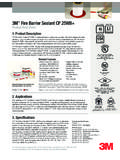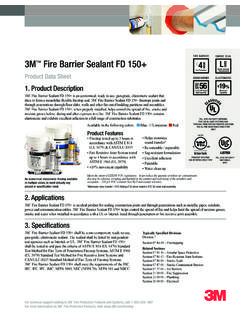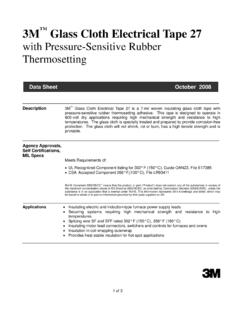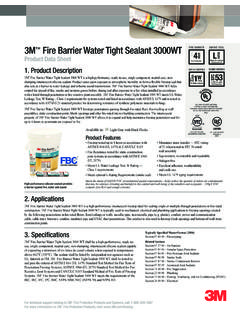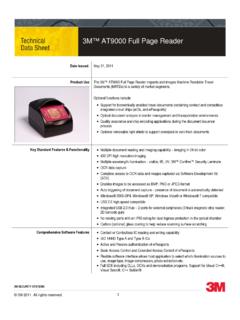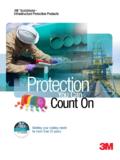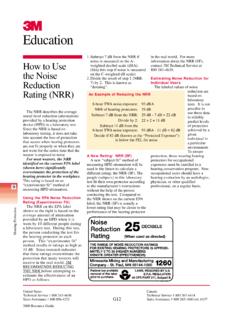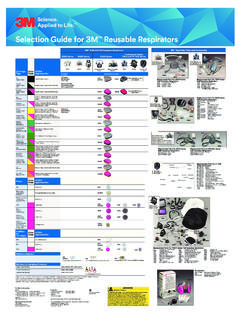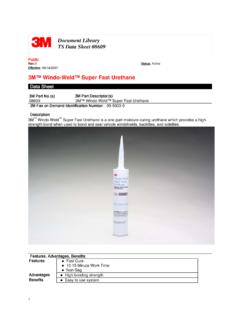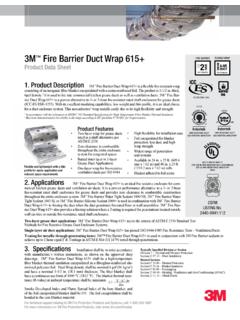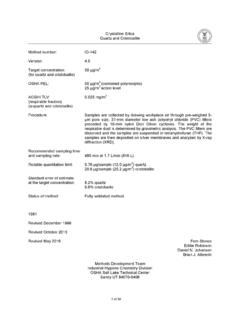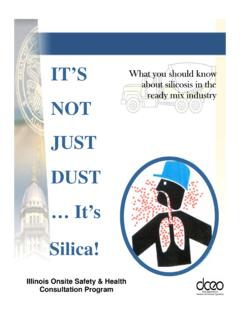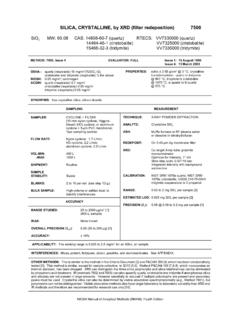Transcription of 3M Technical
1 What is crystalline silica ? crystalline silica is a fundamental constituent of soil, sand, granite and many other minerals. quartz is the most common form of crystalline silica . Cristobalite and tridymite are two other forms of crystalline silica . All three forms may become respirable size particles when workers chip, cut, drill, or grind objects that contain crystalline are the hazards of crystalline silica ? silica exposure is a major threat to workers in high risk jobs such as abrasive blasting, foundry work, stonecutting, rock drilling, quarry work and tunneling. The significance of the health hazards linked with silica exposure is confirmed by the fatalities and disabling illnesses that continue to occur in sandblasters and rock drillers.
2 Breathing crystalline silica dust can cause silicosis, which in serious cases can be disabling, and may result in cancer [1]. There are three kinds of silicosis: chronic, accelerated, and acute. The most common type of chronic silicosis is an occupational disease resulting from moderate contact with crystalline silica over a long period of time [2]. The respirable silica dust enters the lungs and results in the formation of scar tissue, hence decreasing the lungs capacity to absorb oxygen. Silicosis is incurable. Since silicosis affects lung function, it makes one more vulnerable to lung infections like are the symptoms of silicosis?Silicosis is classified into three types: chronic /classic, accelerated and silicosis - the most frequent, occurs after 15 20 years of medium to low contact with respirable crystalline silica .
3 Symptoms associated with chronic silicosis might or might not be apparent; hence, workers need to have a chest x-ray to verify if there is lung damage. As the disease advances, the worker may experience shortness of breath upon exercising and have clinical symptoms of poor oxygen/carbon dioxide exchange. In the advanced stage, the worker may experience fatigue, extreme shortness of breath, chest pain, or respiratory silicosis - can occur after 5 10 years of excessive contact with respirable crystalline silica . Symptoms include severe shortness of breath, weakness, and weight loss. The commencement of symptoms takes longer than in acute silicosis - occurs after a few months or as long as 2 years after contact with exceptionally high concentrations of respirable crystalline silica .
4 Symptoms of acute silicosis comprise severe disabling shortness of breath, weakness, and weight loss, which frequently leads to do construction workers come in contact with crystalline silica ?Contact occurs during many different construction operations. The majority of acute exposures commonly occur during abrasive blasting with sand to remove paint from concrete structures and other surfaces. Other construction operations that may possibly result in acute contact include: using pneumatic drills, rock drilling, concrete mixing, concrete drilling, brick and concrete block cutting and sawing, tunnelling do employees in other industries come in contact with crystalline silica dust?The most acute contact with crystalline silica results from abrasive blasting, which is performed to clean and smooth irregularities from moulds, jewellery, and foundry castings, finish stone masonry, etch or frost glass, or remove paint, oils, rust, or dirt from items that require repainting or treating.
5 Other contacts with silica dust occur in cement and brick manufacturing, china and ceramic manufacturing and the tool and die, steel and foundry industries. crystalline silica is used in manufacturing, household abrasives, adhesives, paints, soaps, and glass. In addition, crystalline silica exposures may occur in the maintenance, repair and replacement of refractory brick furnace linings. In the maritime industry, shipyard employees come in contact with silica primarily in abrasive blasting operations to remove paint and clean and prepare steel hulls, bulkheads, decks, and tanks for paints and Technical BulletinRespirable crystalline SilicaEmployees should know: that dust from stone, brick, tile and concrete can cause silicosis, which leads to disablement and early death; to avoid breathing in dust; to do the job in the correct way and minimise dust clouds; to always use the dust suppression and extraction equipment properly; to keep this equipment clean and working properly; if equipment is not working - report it; to keep their protective equipment clean, and wear it properly.
6 To keep surfaces clean as this helps to prevent dust being made airborne again; to wash dust off skin to avoid cotton or knitted clothing; and to vacuum clean, not should ensure that employees: use the controls provided; follow the correct work method; turn up for health surveillance; and are following the rules on personal hygiene [3].The table below lists COSHH Essentials guidance for various work involving crystalline silica and gives the assigned protection factor suggested for respiratory protective equipment used to control exposure during the guidance around reducing exposure to crystalline silicaOperationAssigned Protection Factor (APF)StonemasonsCutting and polishing20 Hand and pneumatic chiselling40 ConstructionConcrete scabbling40 Drilling and coring with hand held rotary power tools40 Clearing and removing rubble10 Abrasive blasting40 Tunnelling and shaft sinking40 FoundriesCore making and shell moulding (small scale)10 Sand plant20 Furnace relining40 Abrasive blasting (small casting in a cabinet)
7 20 For more information please refer to HSE website [4].How can 3M help reduce exposure to crystalline silica ?3M respiratory protective equipment3M safety eyewear equipment3M hearing protection equipment3M is mindful of staying up to date about hazards associated with crystalline silica . 3M provides advice, information and Technical support on the selection and use of Personal Protective Equipment through its Health and Safety Helpline. A range of Technical literature, posters, selection guides and fact sheets are freely available from 3M Health and Safety Helpline to help its customers with their safety requirements Respirable crystalline silica is a particulate hazard therefore can be captured on filters. A range of 3M, disposable, reusable half face respirators, full face respirators and powered respirators can be used depending on the level of protection required by risk assessment, HSE guidance and their suitability for the task.
8 The 3M range of half and full face masks incorporates a wide range of features designed to ensure a comfortable fit in a wide variety of 93323M Jupiter turbo unit + S-Series headtopOptime IIClassic ear plug3M 7500 + P3 filter3M 6000 + P3 filterMetaliks (various lens options available)2890 APF 20 Powered air and headtopHearing ProtectionEye wearAPF 40 Please recycle. Printed in the United Kingdom. 3M 2009. All rights Health & Environmental Safety Group3M United Kingdom plc3M CentreCain Road, BracknellBerkshire RG12 8 HTTel: 0870 60 800 Health & Environmental Safety Group3M IrelandThe Iveagh BuildingThe ParkCarrickminesDublin 18 Tel: 1 800 320 500 References:1. OSHA crystalline silica Exposure Health Hazard Information2.
